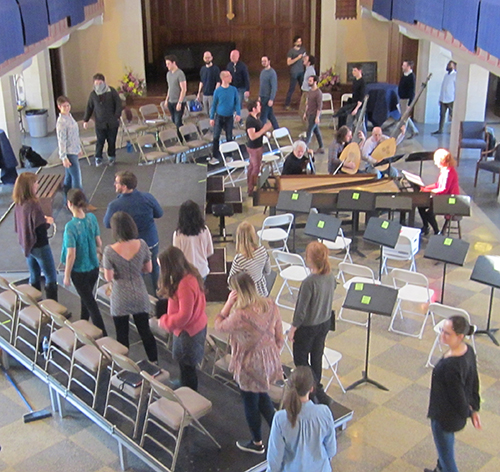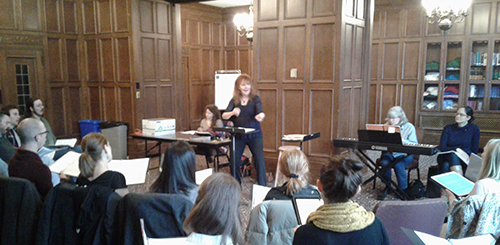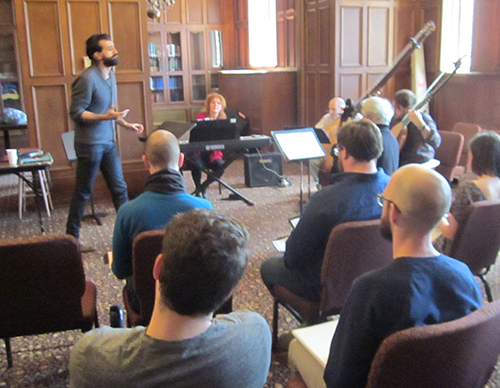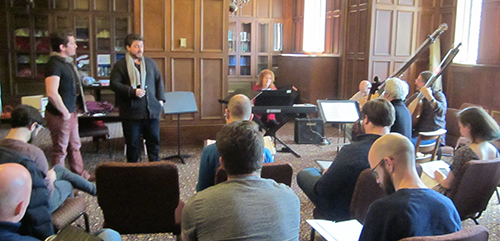by Daniel Hathaway

Me? I wish I had been able to attend the rehearsals — which often prove as interesting as the performances themselves. Rehearsals are where artistic philosophies get established, deals are made between directors and performers, and kinks get worked out. When the piece in question is a staged work, the rehearsal process becomes more complex: the ideas (and egos) of more than one director need to be melded into a single product, and there’s much more that can go awry.
Apollo’s Fire will produce three semi-staged performances of Monteverdi’s L’Orfeo in the next week: two in Kulas Hall at the Cleveland Institute of Music on Friday and Saturday, April 13 and 14 at 7:30 pm, and one at St. Raphael Church in Bay Village on Wednesday, April 18 at 7:30 pm. Between those dates, the company will take the production to Hill Auditorium at the University of Michigan on April 15, and then on to California for performances in Berkeley and Sonoma on April 20 and 22.
The cast for Monteverdi’s “Favola di musica,” which tells the ancient Greek story of Orpheus’ descent into the Underworld to rescue Euridice, includes ten soloists — Karim Sulayman, Erica Schuller, Amanda Powell, Amanda Crider, Molly Netter, Madeline Apple Healy, Owin McIntosh, Jacob Perry, Mischa Bouvier, and Jonathan Woody — as well as dancer Carlos Fittante. The nineteen chorus members include some of the soloists. The colorful instrumental forces comprise a string band of six players, a wind band of nine (including clarino and slide trumpets, sackbuts, cornetti, and recorders) and a continuo band of five (including theorbos, guitars, Baroque triple harp, organ, regale, and harpsichord).
Scheduling and planning rehearsals is a complicated business. Vocal coaching for soloists with Jeannette Sorrell and staging with director Sophie Danneman began on April 2 and 3, and all the principal singers were worked into vocal and staging sessions on April 4 and 5.
I joined this work-in-progress for parts of two days beginning on Friday afternoon, April 6, when the whole roster of singers and the chorus came together for a piano rehearsal in a paneled room on the second floor of the parish hall at St. Paul’s Episcopal Church in Cleveland Heights.

Impressively, the choristers had already mostly memorized their often complicated parts, having been warned at the top of the rehearsal schedule that they would be performing “off book.” And they would be singing with straight tone, a matter Sorrell reminded them of throughout the afternoon, saying that the use of vibrato affected the poetic stress of syllables, making weak syllables strong.
When it comes to Baroque performance style, Sorrell leaves little to chance — she marks up the chorus’ music with a variety of articulations. One annotation — shaped a bit like a cartoonish whale — indicates the kind of swelling and easing off of tone that she wants the singers to use to enliven long notes.


The second half of Saturday afternoon’s session was devoted to a work-through of the first half of L’Orfeo on the set with Jeannette Sorrell at the harpsichord and the continuo department at her right hand. (The second harpsichord will be manned by none other than Thomas Forrest Kelly, who will also play the regale, a reed organ, during Orpheus’ trip to Hades.)
Although there’s not a lot of action involved — and there wasn’t much room for any at the premiere of the show in 1607, which took place in a modestly-sized room of the Ducal Palace in Mantua — a lot can be suggested by small gestures. One amusing moment on Saturday came when Karim Sulayman was to be crowned with flowers. It took several tries to get the garland to sit properly on his head without either descending onto his nose or assuming a rakish angle. This is one reason why we have rehearsals.

Published on ClevelandClassical.com April 10, 2018.
Click here for a printable copy of this article



